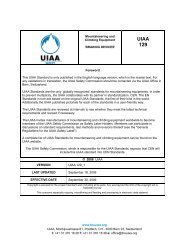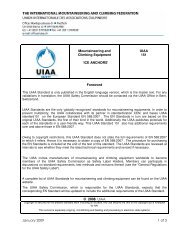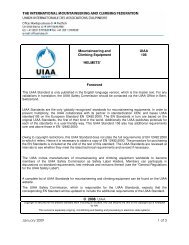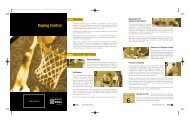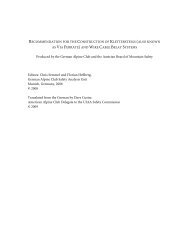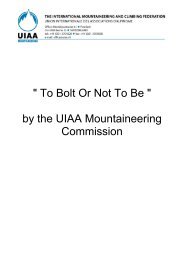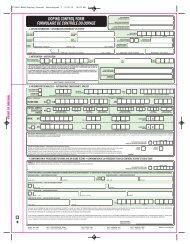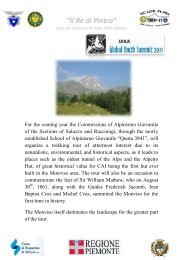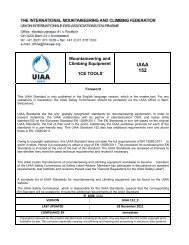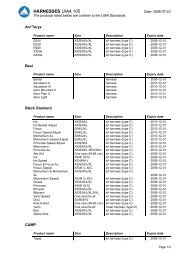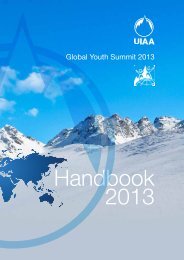Model Training Standards - UIAA
Model Training Standards - UIAA
Model Training Standards - UIAA
You also want an ePaper? Increase the reach of your titles
YUMPU automatically turns print PDFs into web optimized ePapers that Google loves.
<strong>UIAA</strong> <strong>Standards</strong> for<br />
Voluntary Leaders and Instructors<br />
Guidance notes for Member Associations’<br />
<strong>Training</strong> and Assessment schemes<br />
2nd Edition,<br />
Agreed by<br />
<strong>UIAA</strong> Mountaineering Commission, 14/4/07<br />
Page 1 of 17
<strong>UIAA</strong> <strong>Standards</strong> for Voluntary Leaders and Instructors<br />
Guidance notes for Member Associations’ training and assessment schemes<br />
Introduction and summary<br />
A. General Requirements<br />
1. Evaluation Procedure<br />
2. Common basis<br />
3. Approval<br />
B. Activity <strong>Standards</strong><br />
Specifications for pre-training experience, skills and knowledge<br />
1. Mountain Walking and Trekking (summer)<br />
2. Winter Mountain Walking and Snowshoeing<br />
3. Sport Climbing (indoor and outdoor)<br />
4. Rock Climbing (leader placed protection)<br />
5. Ice Climbing<br />
6. Alpine Climbing<br />
7. Ski Mountaineering<br />
C. Additional Requirements<br />
Additional syllabus and scheme requirements for specific environments<br />
1. High Altitude<br />
2. Specific Regions<br />
3. Avalanche Terrain<br />
Annexe<br />
Page 2 of 17
Introduction<br />
Background<br />
The <strong>UIAA</strong> Mountaineering Commission developed <strong>Model</strong> <strong>Training</strong> <strong>Standards</strong> for Voluntary<br />
Leaders and Instructors in response to requests from Member Associations for guidance on widely<br />
accepted good practice and standards for training schemes. These were adopted by the General<br />
Assembly in 1993 (Santiago de Chile) and the Mountaineering Commission formed a <strong>Training</strong><br />
<strong>Standards</strong> Working Group (TSWG) to assist Member Associations wishing to use the original four<br />
standards. In 2001 and 2003 the TSWG held seminars (Le Tour, France) to discuss the use and<br />
application of the standards. 39 standards were approved between 1993 and 2005,<br />
Developments in 2005<br />
After a period of over 10 years successful use of the standards, a third TSWG seminar was held in<br />
June 2005 (Steingletscher, Switzerland). This seminar reviewed the content and structure of the<br />
existing standards and discussed the need for modifications and additional standards. The<br />
seminar noted that:<br />
The needs and circumstances of Member Associations can be very different around the<br />
world.<br />
The expertise in national training requirements is in the Member Associations.<br />
The TSWG provides a very valuable service to national federations by evaluating their<br />
training schemes and verifying these meet common international standards.<br />
Hence, in order to better accommodate to the needs of Member Associations the seminar<br />
proposed to build on the success of the four original standards by:<br />
a) Creating a flexible framework for activities that could better accommodate the different<br />
needs and circumstances of federations around the world.<br />
b) Place greater emphasis on the process for evaluating the scheme and the work between<br />
the TSWG Expert and the Member Association.<br />
The above proposal represented a shift in emphasis away from the concept of uniform technical<br />
standards for the candidates being trained by the Member Associations, and towards the quality of<br />
the process by which the candidates are trained and assessed. The proposals from the seminar<br />
were further refined by the TSWG and the Mountaineering Commission, and were adopted as the<br />
new basis for evaluating training schemes from October 2006.<br />
The TSWG welcomes comments on the <strong>Training</strong> <strong>Standards</strong>, and will revise them from time to<br />
time.<br />
Scope<br />
Member Associations have total discretion to use or not use the <strong>Training</strong> <strong>Standards</strong> in their own<br />
country. There is no <strong>UIAA</strong> requirement to make use of the <strong>Standards</strong> or the evaluation offered by<br />
the TSWG. Member Associations alone have the responsibility for training and assessing their<br />
national leaders and instructors. The Member Associations also have the responsibility to ensure<br />
that requirements are met for relevant national legislation and insurance.<br />
The use of the <strong>UIAA</strong> <strong>Training</strong> <strong>Standards</strong> is a means by which Member Associations can<br />
demonstrate their training and assessment schemes have been independently evaluated and meet<br />
accepted standards. The use of the standards also allows opportunities for mutual recognition of<br />
qualifications between Member Associations.<br />
The TSWG has developed the <strong>Training</strong> <strong>Standards</strong> specifically with the needs in mind of Member<br />
Associations and their leaders and instructors working in a voluntary capacity with other members<br />
of their federation. However, Member Associations may wish to apply the <strong>Standards</strong> in wider<br />
Page 3 of 17
circumstances (e.g. for leaders and instructors who are paid, and who might be working with the<br />
public). Where this is the case, the Member Association concerned is responsible for ensuring<br />
their scheme meets the applicable standards in their country for the wider application of the <strong>UIAA</strong><br />
<strong>Training</strong> <strong>Standards</strong>.<br />
In the context of the <strong>UIAA</strong> <strong>Training</strong> <strong>Standards</strong> the following definitions apply:<br />
A leader is a person who can take responsibility for other people and lead or supervise an activity.<br />
An instructor is a person who can teach people including beginners so they are competent to<br />
take part in an activity.<br />
Application and Evaluation<br />
Member Associations wishing to apply for a <strong>UIAA</strong> <strong>Training</strong> Standard should contact the President<br />
of the TSWG (who is contactable via the <strong>UIAA</strong> office). The TSWG will appoint an Expert to work<br />
with the Member Association and evaluate the proposed Scheme. The expert will:<br />
a) Evaluate the scheme that has been proposed in relation to the relevant <strong>UIAA</strong> <strong>Training</strong><br />
Standard.<br />
And where appropriate:<br />
b) Help the Member Association improve their scheme and meet the <strong>UIAA</strong> <strong>Training</strong> Standard.<br />
c) Produce a report and make a recommendation to the <strong>UIAA</strong> Mountaineering Commission.<br />
The process of the Member Association working with the TSWG and the Expert is the most<br />
important and valuable aspect of the <strong>UIAA</strong> <strong>Training</strong> Standard.<br />
Page 4 of 17
A. General Requirements<br />
1. Evaluation<br />
Documentation<br />
The first step is for the Member Association to submit a dossier with all the relevant information<br />
and documentation about the scheme that they wish to be evaluated. This will then be reviewed<br />
by the TSWG, and an Expert will be appointed to work with the Member Association to carry out<br />
the evaluation.<br />
The dossier should contain an outline of the training scheme that is being submitted for approval.<br />
The scheme should contain a training course, an experience period, and an assessment course.<br />
The proposed scheme can be for a leader or an instructor. If the scheme is for an instructor, the<br />
candidate must be assessed for their teaching skills.<br />
The proposed scheme should include the following information:<br />
The purpose of the scheme.<br />
Description of the qualification.<br />
Definition of the qualification holder’s role.<br />
Definition of the limits of the qualification.<br />
Candidates’ pre-training requirements (this must include first aid).<br />
The skills and knowledge included in the training and the means by which they will be<br />
assessed (see requirements in section B and C).<br />
The requirements for on-going training of the qualification holder, and the revalidation of<br />
the qualification.<br />
The qualification may be in different formats depending upon the circumstances and needs of the<br />
Member Association. The format of the qualification may be one or more of the following:<br />
Award<br />
Certificate<br />
Log book<br />
Licence<br />
Evaluation visit<br />
Once any points of clarification in the documentation have been dealt with, the Expert and Member<br />
Association will agree a visit (or visits) to evaluate the proposed scheme.<br />
Cost<br />
The costs of evaluation visits are the responsibility of the Member Association requesting approval,<br />
though the experts are often able to provide their time without charge. However, the <strong>UIAA</strong> has a<br />
modest development budget that may be available in some circumstances, and the <strong>UIAA</strong> is willing<br />
to assist in applications for development funding from other agencies.<br />
Page 5 of 17
Evaluation categories<br />
The TSWG Expert will review whatever aspects he or she believes is relevant to the application<br />
made by the Member Association, but this will include:<br />
Member Association representation of Federation<br />
Adequate facilities<br />
Appropriate terrain<br />
Competent senior instructors<br />
Candidates with appropriate experience and skills, who are fit to be trained and assessed<br />
Programme design and management<br />
<strong>Training</strong> methods<br />
Assessment procedures<br />
Scheme review system<br />
Procedure for dealing with complaints and appeals<br />
2. Common Basis<br />
The title '<strong>UIAA</strong> <strong>Training</strong> Standard' indicates that a Member Association has a structured training<br />
and assessment scheme for voluntary leaders and/or, instructors that has been validated by<br />
independent examination by a <strong>UIAA</strong> Expert.<br />
The designation of the title '<strong>UIAA</strong> <strong>Training</strong> Standard' to a Member Association is an indication that<br />
the training and assessment scheme meets the relevant technical standards for the activity<br />
bearing in mind the needs of the federation and the environment and facilities in their country.<br />
The designation is also an indication that the Federation’s scheme is in accordance with other<br />
<strong>UIAA</strong> policies such as the Environmental Guidelines and Objectives and the Summit Charter (both<br />
available from the <strong>UIAA</strong> website). For example, the Summit Charter includes the <strong>UIAA</strong>’s<br />
commitment to promoting equal opportunities for all people taking part in climbing and<br />
mountaineering. Therefore, training schemes are expected to demonstrate a positive attitude<br />
towards equal opportunities. (Equality of access)<br />
3. Approval<br />
Once the Expert has completed the evaluation, he or she will submit a report to the TSWG. The<br />
President of the TSWG will inform the Member Association of the outcome of the evaluation, if<br />
they have been awarded the ‘<strong>UIAA</strong> <strong>Training</strong> Standard’, and if there are any special considerations<br />
or limitations that might apply.<br />
The authorisation to use the term ‘<strong>UIAA</strong> <strong>Training</strong> Standard’ may only be applied by the Member<br />
Association to the specific scheme that has been evaluated. The authorisation may be withdrawn<br />
by the TSWG if it is concerned that the scheme no longer meets the relevant standard or the<br />
constitution of the Member Association has substantially changed, but normally the authorisation is<br />
valid for a period of 5 years and can be renewed. The <strong>UIAA</strong> reserves the right to review the articles<br />
of association of the Member Association within the 5 year period.<br />
Once authorised the Member Association may use the <strong>UIAA</strong> logo and term ‘<strong>UIAA</strong> <strong>Training</strong><br />
Standard’ on the documentation for the approved scheme and any certificates or identity cards<br />
held by the qualified persons. The certificate or identity card must clearly state the scope and<br />
limits of the qualification held, and the identity of the person holding the qualification.<br />
Page 6 of 17
B. Activity <strong>Standards</strong><br />
The following set out the minimum specifications for pre-training experience, skills and knowledge<br />
that should be the content of the scheme being proposed for approval. Where appropriate the<br />
Activity <strong>Standards</strong> may be used in combination. If the proposed scheme includes activities at highaltitude,<br />
in tropical regions or avalanche terrain, it must be used in conjunction with the relevant<br />
Additional <strong>Standards</strong>.<br />
1. Mountain Walking and Trekking (summer)<br />
This standard may include steep terrain, scrambling, and overcoming obstacles such as small rock<br />
steps and patches of snow or ice. This standard is not designed for use in situations that require<br />
the techniques of mountaineering to make progress, such as rock or ice climbing.<br />
1.1 The scheme must define the type of terrain that it applies to, and the type of terrain that is<br />
outside the scope of the qualification.<br />
1.2 The candidate should not be less than 18 years old at the time of assessment.<br />
1.3 Pre training experience<br />
The scheme must include a defined minimum of experience (e.g. years, number and type<br />
of mountain walks or treks, different areas and terrain, etc.).<br />
1.4 Skills<br />
The scheme should test the candidates’ ability to demonstrate effective personal<br />
techniques and ability in the following areas:<br />
1. Safe movement ascending, descending and traversing mountain terrain<br />
including:<br />
Steep ground*<br />
‘Broken’ or uneven terrain*<br />
Ridges*<br />
Gullies*<br />
Easy rock steps*<br />
Snow covered ground*<br />
2. Basic rope work*<br />
3. Route finding and navigation through typical and difficult terrain<br />
4. Journey planning for groups<br />
5. Organisation and group leadership<br />
6. Camping and bivouacs<br />
7. Avoiding and solving common problems<br />
8. Emergency procedures<br />
9. First aid<br />
* If included in the scope of the scheme<br />
1.5 Knowledge<br />
The scheme should test the candidates’ knowledge about and their ability to give advice on<br />
the following:<br />
1. Recognition and treatment of exhaustion, hypothermia, cold injury and heat<br />
disorders<br />
2. Terrain and weather hazards<br />
3. Journey planning, route choice, route grades, way marks and guidebooks<br />
4. Camping and mountain huts<br />
5. Nutrition<br />
6. Physiology and injury prevention<br />
7. Emergency procedures<br />
8. Environment and mountain culture<br />
9. Access<br />
10. Legal liability and insurance<br />
11. <strong>Training</strong><br />
Page 7 of 17
2. Winter Mountain Walking and Snowshoeing<br />
This standard may be limited to low angle terrain or tracks that have very limited exposure to<br />
avalanche hazards or are in avalanche-controlled areas. However, if the scope of the scheme is<br />
to include travel in avalanche terrain it must be used in conjunction with the Avalanche standard.<br />
This standard is not designed for use in situations that require the techniques of mountaineering to<br />
make progress, such as rock or ice climbing.<br />
2.1 The scheme must define the type of terrain that it applies to, and the type of terrain that is<br />
outside the scope of the qualification.<br />
2.2 The candidate should not be less than 18 years old at the time of assessment.<br />
2.3 Pre training experience<br />
The scheme must include a defined minimum of experience (e.g. years, number and type<br />
of mountain walks or treks, different areas and terrain, etc.).<br />
2.4 Skills<br />
The scheme should test the candidates’ ability to demonstrate effective personal<br />
techniques and ability in the following areas:<br />
1. Safe movement ascending, descending and traversing mountain terrain<br />
including:<br />
Steep ground*<br />
‘Broken’ or uneven terrain*<br />
Ridges*<br />
Gullies*<br />
Easy rock steps*<br />
2. Basic rope work*<br />
3. Route finding and navigation through typical and difficult terrain<br />
4. Journey planning for groups<br />
5. Organisation and group leadership<br />
6. Camping and bivouacs<br />
7. Avoiding and solving common problems<br />
8. Emergency procedures<br />
9. First aid<br />
* If included in the scope of the scheme<br />
2.5 Knowledge<br />
The scheme should test the candidates’ knowledge about and their ability to give advice on<br />
the following:<br />
1. Recognition and treatment of exhaustion, hypothermia, cold injury and heat<br />
disorders<br />
2. Terrain and weather hazards<br />
3. Avalanche hazard awareness<br />
4. Journey planning, route choice, route grades, way marks and guidebooks<br />
5. Camping and mountain huts<br />
6. Nutrition<br />
7. Physiology and injury prevention<br />
8. Emergency procedures<br />
9. Environment and mountain culture<br />
10. Access<br />
11. Legal liability and insurance<br />
12. <strong>Training</strong><br />
Page 8 of 17
3. Sport Climbing (i.e. single or multi-pitch fixed equipment)<br />
A sport climb is defined as being fully equipped with bolts for protection and belay anchors. This<br />
standard is only valid for climbing areas with easy approaches and descents (i.e. no navigation or<br />
mountaineering skills required).<br />
3.1 The scheme must define if it is limited to single pitch climbs, multi pitch climbs and/or<br />
artificial climbing walls.<br />
3.2 The candidate should not be less than 18 years old at the time of assessment.<br />
3.3 Pre training experience<br />
- The candidate must have experience of on-sight leading grade 5 (<strong>UIAA</strong>).<br />
- The scheme must include a defined minimum of experience (e.g. years, number of<br />
climbs, rock types, areas, etc.).<br />
3.4 Skills<br />
The scheme should test the candidates’ ability to demonstrate effective personal<br />
techniques and ability in the following areas:<br />
1. On-sight lead efficiently<br />
2. Climbing movement skills<br />
3. Bouldering<br />
4. Basic coaching and teaching<br />
5. Group management and leadership<br />
6. Climbing calls<br />
7. Rope management, knots, quick draws, belays and belaying<br />
8. Abseiling<br />
9. Emergency procedures<br />
10. Avoiding and solving common problems<br />
11. First aid<br />
3.5 Knowledge<br />
The scheme should test the candidates’ knowledge about and their ability to give advice on<br />
the following:<br />
1. Climbing equipment (e.g. footwear, belay devices and descenders, helmets,<br />
harness, ropes, slings, karabiners, etc.)<br />
2. Care of equipment<br />
3. Safety chains and fall factors<br />
4. Types of bolts and anchors<br />
5. Rock types<br />
6. Ethics and tradition<br />
7. Route choice, grades and use of guidebooks<br />
8. Environment and access<br />
9. Risk management, safety and emergency procedures<br />
10. Nutrition<br />
11. Physiology and injury prevention<br />
12. Personal liability and insurance<br />
13. <strong>Training</strong><br />
14. Competitions<br />
Page 9 of 17
4. Rock Climbing (with leader placed protection, and single or multipitch)<br />
This standard is only valid for climbing areas with easy approaches and descents (i.e. no<br />
navigation or mountaineering skills required) unless it is combined with the Mountain Walking and<br />
Trekking (summer) standard.<br />
4.1 The scheme must define if it is for single pitch or multi pitch climbs.<br />
4.2 The candidate should not be less than 18 years old at the time of assessment.<br />
4.3 Pre training experience<br />
- The candidate must have experience of on-sight leading 5 (<strong>UIAA</strong>).<br />
- The scheme must include a defined minimum of experience (e.g. years, number of<br />
climbs, rock types, areas, etc.).<br />
4.4 Skills<br />
The scheme should test the candidates’ ability to demonstrate effective personal<br />
techniques and ability in the following areas:<br />
1. On-sight lead efficiently<br />
2. Select and place protection equipment including multi-point anchors<br />
3. Rope management, knots, running belays, and belaying<br />
4. Single and double rope techniques<br />
5. Route finding<br />
6. Climbing movement skills<br />
7. Bouldering<br />
8. Basic coaching and teaching<br />
9. Group management and leadership<br />
10. Climbing calls<br />
11. Abseiling<br />
12. Emergency procedures<br />
13. Avoiding and solving common problems<br />
14. First aid<br />
4.5 Knowledge<br />
The scheme should test the candidates’ knowledge about and their ability to give advice on<br />
the following:<br />
1. Climbing equipment (e.g. footwear, belay devices and descenders, helmets,<br />
harness, ropes, slings, karabiners, protection equipment, etc.)<br />
2. Care of equipment<br />
3. Types of anchors (chocks, camming devices, bolts, etc.)<br />
4. Dynamic safety system (e.g. impact forces, safety chain and fall factors).<br />
5. Rock types<br />
6. Ethics and tradition<br />
7. Route choice, grades and use of guidebooks<br />
8. Environment and access<br />
9. Risk management, safety and emergency procedures<br />
10. Nutrition<br />
11. Physiology and injury prevention<br />
12. Personal liability and insurance<br />
13. <strong>Training</strong><br />
Page 10 of 17
5. ICE CLIMBING<br />
This standard is only valid for climbs with easy approaches and descents (i.e. no navigation skills<br />
required and minimal exposure to hazards). If the scope of the scheme is to include travel in<br />
avalanche terrain, it must be used in conjunction with the Avalanche standard.<br />
5.1 The scheme must define if it includes dry tooling and/or mixed climbing.<br />
5.2 The candidate should not be less than 18 years old at the time of assessment.<br />
5.3 Pre training experience<br />
- The candidate must have experience of leading multi-pitch ice climbs at grade WI III.<br />
- The scheme must include a defined minimum of experience (e.g. years, number and<br />
type of climbs, areas, etc.).<br />
5.4 Skills<br />
The scheme should test the candidates’ ability to demonstrate effective personal<br />
techniques and ability in the following areas:<br />
1. On-sight lead efficiently<br />
2. Select and place protection equipment including multi-point anchors<br />
3. Rope management, knots, running belays, and belaying<br />
4. Single, twin and double rope techniques<br />
5. Route finding<br />
6. Climbing movement skills<br />
7. Basic coaching and teaching<br />
8. Group management and leadership<br />
9. Climbing calls<br />
10. Abseiling<br />
11. Emergency procedures<br />
12. Avoiding and solving common problems<br />
13. First aid<br />
5.5 Knowledge<br />
The scheme should test the candidates’ knowledge about and their ability to give advice on<br />
the following:<br />
1. Climbing equipment (e.g. ice tools, crampons, footwear, clothing, ice screws,<br />
belay devices and descenders, helmets, harness, ropes, slings, karabiners,<br />
protection equipment, etc.)<br />
2. Care of equipment<br />
3. Risk management, safety and emergency procedures<br />
4. Dynamic safety system (e.g. impact forces, safety chain and fall factors).<br />
5. Winter hazards.<br />
6. Managing in the cold environment.<br />
7. Prevention and treatment of cold injury and hypothermia.<br />
8. Protection from solar radiation.<br />
9. Ice types and formations<br />
10. Ethics and tradition<br />
11. Different climbing styles and techniques<br />
12. Dry-tooling and mixed climbing<br />
13. Route choice, grades and use of guidebooks<br />
14. Environment and access<br />
15. Nutrition<br />
16. Physiology and injury prevention<br />
17. Personal liability and insurance<br />
18. <strong>Training</strong><br />
Page 11 of 17
6. Alpine Climbing<br />
6.1 The scheme must define the type of terrain that it applies to, and the type of terrain (if any)<br />
that is outside the scope of the qualification.<br />
6.2 The candidate should not be less than 21 years old at the time of assessment.<br />
6.3 Pre training experience<br />
The scheme must include a defined minimum of experience (e.g. years, number and type<br />
of journeys and ascents, different areas, etc.). Candidates should be:<br />
Active alpine climbers with experience of ascents on snow, ice and rock.<br />
Able to lead <strong>UIAA</strong> Grade 4 alpine rock and 50° ice.<br />
Experienced in glacier travel.<br />
6.4 Skills<br />
The scheme should test the candidates’ ability to demonstrate effective personal<br />
techniques and ability in the following areas:<br />
1. Safe movement ascending, descending and traversing alpine terrain including:<br />
Steep ground<br />
Ridges<br />
Gullies<br />
Rock, ice and mixed steps<br />
Glacier travel<br />
Crevasse evacuation techniques<br />
2. Use of ice axe and crampons<br />
3. On-sight lead rock, ice and mixed ground efficiently<br />
4. Select and place protection equipment including multi-point anchors<br />
5. Rope management, knots, running belays, and belaying<br />
6. Single, twin and double rope techniques<br />
7. Route finding and navigation<br />
8. Climbing movement skills<br />
9. Basic coaching and teaching<br />
10. Group management and leadership<br />
11. Climbing calls<br />
12. Abseiling<br />
13. Emergency procedures<br />
14. Avoiding and solving common problems<br />
15. First aid<br />
6.5 Knowledge<br />
The scheme should test the candidates’ knowledge about and their ability to give advice on<br />
the following:<br />
1. Climbing equipment (e.g. ice tools, crampons, footwear, clothing, ice screws,<br />
belay devices and descenders, helmets, harness, ropes, slings, karabiners,<br />
protection equipment, etc.)<br />
2. Care of equipment<br />
3. Terrain and weather hazards<br />
4. Risk management, safety and emergency procedures<br />
5. Dynamic safety system (e.g. impact forces, safety chain and fall factors)<br />
6. Prevention and treatment of cold injury and hypothermia<br />
7. Protection from solar radiation<br />
8. Ethics and tradition<br />
9. Different climbing styles and techniques<br />
10. Route choice, grades and use of guidebooks<br />
11. Environment and access<br />
12. Nutrition<br />
13. Physiology and injury prevention<br />
14. Personal liability and insurance<br />
15. <strong>Training</strong><br />
Page 12 of 17
7. Ski Mountaineering<br />
This standard must be used in conjunction with the Avalanche Standard (section C).<br />
7.1 The scheme must define the type of terrain that it applies to, and the type of terrain (if any)<br />
that is outside the scope of the qualification (e.g. if the scheme includes glacier terrain or<br />
not).<br />
7.2 The candidate should not be less than 21 years old at the time of assessment.<br />
6.3 Pre training experience<br />
The scheme must include a defined minimum of experience (e.g. years, number and type<br />
of tours and journeys, different areas, etc.). Candidates should be:<br />
Active ski mountaineers with experience of ascents, descents and multi-day tours.<br />
Able to ski in control off-piste in difficult snow conditions.<br />
Knowledgeable about safe glacier travel and alpine mountaineering techniques*<br />
6.4 Skills<br />
The scheme should test the candidates’ ability to demonstrate effective personal<br />
techniques and ability in the following areas:<br />
1. Good downhill skiing technique in a variety of off-piste snow conditions<br />
2. Good ascending technique on skins and crampons<br />
3. Risk awareness and risk reduction<br />
4. Route finding and navigation<br />
5. Glacier travel and crevasse evacuation*<br />
6. Alpine mountaineering techniques*<br />
7. Basic coaching and teaching<br />
8. Group management and leadership<br />
9. Emergency procedures<br />
10. Avoiding and solving common problems<br />
11. First aid<br />
*If included in the scope of the scheme<br />
5.5 Knowledge<br />
The scheme should test the candidates’ knowledge about and their ability to give advice on<br />
the following:<br />
1. Ski mountaineering equipment and clothing<br />
2. Care of equipment<br />
3. Terrain and weather hazards<br />
4. Risk management, safety and emergency procedures<br />
5. Prevention and treatment of cold injury and hypothermia<br />
6. Protection from solar radiation<br />
7. Traditions and ski mountaineering competitions<br />
8. Route choice, grades and use of guidebooks<br />
9. Environment and access<br />
10. Nutrition<br />
11. Physiology and injury prevention<br />
12. Personal liability and insurance<br />
13. <strong>Training</strong><br />
Page 13 of 17
C. Additional Requirements<br />
The Additional Requirements are to be used where appropriate with the Activity <strong>Standards</strong>.<br />
1. High Altitude<br />
The scheme must include experience, skills and knowledge about:<br />
1. The process of acclimatisation<br />
2. The symptoms and treatment for mountain sickness<br />
3. Emergency procedures in the event of acute mountain sickness<br />
2. Specific Regions<br />
The scheme must include experience, skills and knowledge about:<br />
1. Special environmental considerations<br />
2. Special environmental hazards<br />
3. Survival techniques<br />
3. Avalanche Terrain<br />
The scheme must include experience, skills and knowledge about:<br />
1. Snow structure, avalanche types, terrain features and triggers<br />
2. Avalanche information, observations and decision making<br />
3. Rescue organisation, searching and emergency care<br />
Page 14 of 17
Annexe<br />
Those who assisted in the production of the original standards include:<br />
Alan Blackshaw BMC, Chair of the Mountaineering Commission<br />
André Rieder SAC, Switzerland<br />
Giancarlo Del Zotto CAI, Italy<br />
Igor Novák CMA, Czech Republic<br />
Lluis Lopez FEDME, Spain<br />
Jordi Colomer FEDME, Spain<br />
Paul Vierin CAF, France<br />
Louis Volle CAF, France<br />
Jean Ruedin FFME, France<br />
Karl Schrag DAV, Germany<br />
Mike Nikkels KNAV, Holland<br />
Iain Peter<br />
BMC, Great Britain<br />
Roger Payne BMC, Great Britain<br />
Eliza Moran AAC, USA<br />
Mike Galbraith ACC, Canada<br />
Patrick Lamarque CAF, France<br />
Phillipe Dedieu FFME, France<br />
Robert Renzler OeAV, Austria<br />
Manel de la Matta FEDME, Spain<br />
John Cousins UKMTB, UK<br />
Those who assisted in the production of the 2005 revised standards include:<br />
2005 TSWG Seminar delegates<br />
First Name Surname Federation Country<br />
Lambert Colas FEEC Catalonia<br />
Gabriel Porti FEEC Catalonia<br />
Jan Bednarik CMA Czech Republic<br />
Karel Kriz CMA Czech republic<br />
Mikael Bo Kristiansen DMC Denmark<br />
Jakob Lapp DMC Denmark<br />
Jari Koski FCA Finland<br />
Kukka Tervaskanto FCA Finland<br />
Patrick Lamarque CAF France<br />
Christos Belogiannis HFMC/EOOA Greece<br />
George Voutyropolous HFMC/EOOA Greece<br />
Jack de Rigk NKBV Holland<br />
SP Chamoli IMF India<br />
Madhuri Chamoli IMF India<br />
Claudio Melchiorri CAI Italy<br />
Michael Pupeza RAC Romania<br />
Llilanna Becea RAC Romania<br />
Andrew Friedemann MCSA South Africa<br />
Michelle Friedemann MCSA South Africa<br />
Xose Manuel Perez Prego FEDME Spain<br />
Carlos Carracedo FEDME Spain<br />
Torbjörn Ohlén SCA Sweden<br />
Roger Payne <strong>UIAA</strong> Switzerland<br />
Yann Smith SAC Switzerland<br />
Nejat Akinci TMF Turkey<br />
Murat Sen TMF Turkey<br />
Murat Salim Sen TMF Turkey<br />
John Cousins MLTUK UK<br />
Simon Hale BMC UK<br />
Page 15 of 17
2011 TRAINING STANDARDS WORKING GROUP MEMBERS:<br />
Christian Frischknecht, SAC, Switzerland<br />
Patrick Lamarque, CAF/FFCAM, France<br />
Steve Long, MLTUK, Great Britain (Chairman)<br />
Jordi Magrina, FEEC, Catalun (application pending)<br />
Claudio Melchiorri, CAI, Italy<br />
Klemen Medja, PZS, Slovenia<br />
Gabriel Porti, FEDME, Spain<br />
Txomin Uriarte, EMF, Basque, Spain<br />
Ron Whitehead ENEQ, Canada (Quebec)<br />
Corresponding members:<br />
John Bicknell, AAC, US<br />
Mr. Ma Xinxiang, CMA, China<br />
Pierre Humblet, CAB-BAC, Belgium President of Mountaineering Commission<br />
Page 16 of 17
SUMMARY OF <strong>UIAA</strong> TRAINING STANDARDS APPROVALS/RE-APPROVALS (03/10/2011)<br />
Country Federation Mountain<br />
Walking<br />
Winter<br />
Walking<br />
Climb<br />
wall<br />
Multipitch<br />
(fixed<br />
gear)<br />
Single<br />
-pitch<br />
trad<br />
Multipitch<br />
trad<br />
ice alpine ski<br />
Belgium CAB 2000<br />
Belgium KBF (2011) 2010 2000<br />
Catalonia FEEC 2010 2010<br />
Czech CMF 2004 2004<br />
Rep.<br />
Denmark DMC 2011<br />
Finland FCA 2010 2005<br />
France CAF/FFCAM 2006 2006 2006 2006<br />
Ireland MI/MLTUK 2005 2010<br />
Italy CAI 2010 2010 2010<br />
Quebec ENEQ 2008 2008 2011 2005 2007<br />
Slovenia PZS 2010 2010 2010<br />
S. Africa MCSA 2005 2005<br />
Spain FEDME 2005 2005 2005 2005<br />
Sweden SCA 2005<br />
United BMC/MLTUK 2005 2010<br />
Kingdom<br />
Norway NF 2010<br />
SEMINAR ATTENDENCE<br />
Country<br />
federation<br />
Federation Experts Seminar Validator<br />
Seminar<br />
2001 2003 2005 2006 2008 2011<br />
Belgium CAB X<br />
Catalonia FEEC X<br />
Czech Rep. CMF X X<br />
Denmark DMC X X X<br />
Finland FCA X X X X<br />
France CAF/FFCAM X X X X X<br />
Ireland MI X X X<br />
Italy CAI X X X X<br />
Quebec ENEQ X X X X X<br />
Slovenia<br />
PZS<br />
S. Africa MCSA X X X<br />
Spain<br />
FEDME<br />
X X X X X<br />
Sweden<br />
SCA<br />
X<br />
X<br />
United Kingdom<br />
BMC<br />
X X X X X X<br />
Turkey TDM X<br />
Russia RMF X<br />
Israel IAC/ ILCC X<br />
Portugal FCMP X X<br />
Canada ACC X X X<br />
Greece EOOA X<br />
Netherland NKBV X X<br />
India IMF X X X<br />
Switzerland CAS X X X<br />
Lithuania LMA X<br />
Phillipines X X<br />
Romania CAR X X<br />
X<br />
Page 17 of 17






